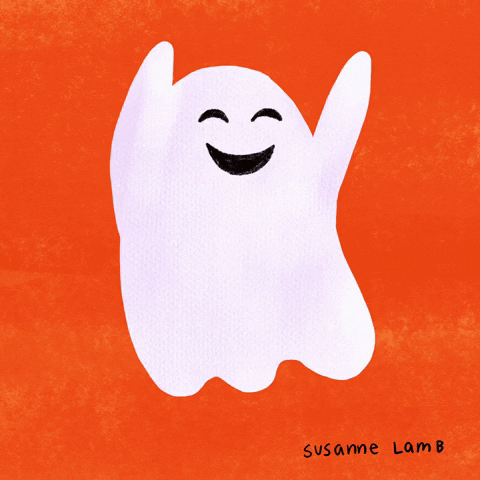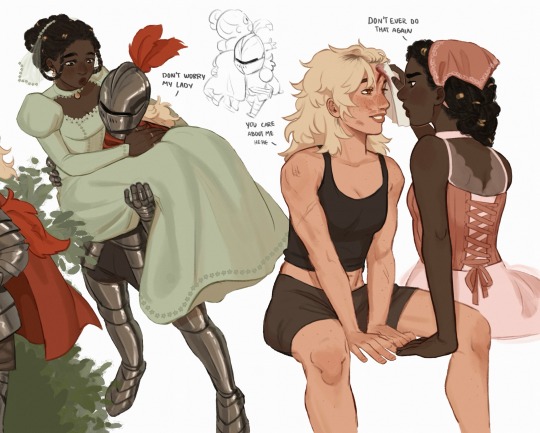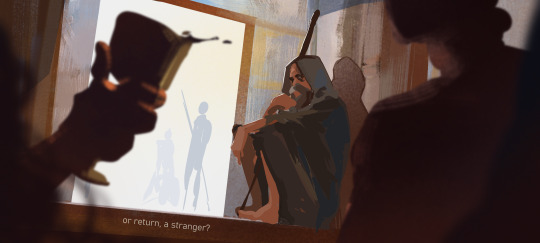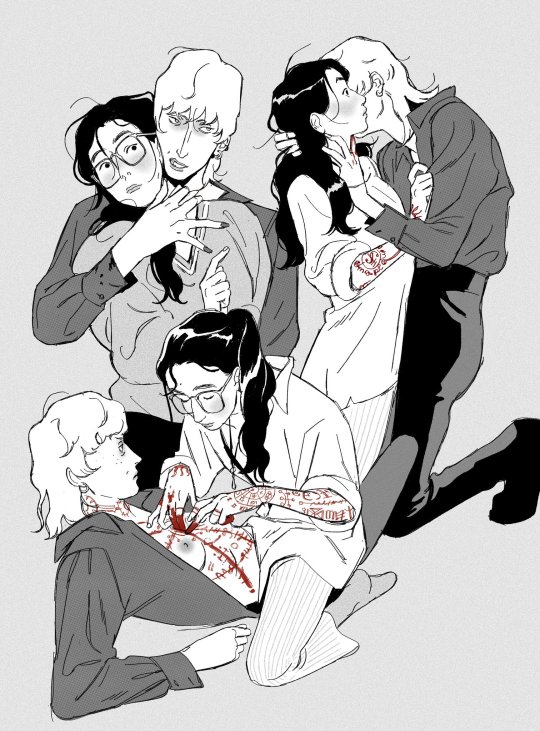Text
eleventh plague. emails.
80K notes
·
View notes
Note
Au where Severus and Sirius are both Harry’s godfathers and have to raise Harry together divorced parent style
Imagine the drop off tension


they are united in their concern!
4K notes
·
View notes
Text
there is a huge difference between criticizing an institution and criticizing individual behavior. i can criticize the makeup industry without criticizing the 14 year old girl who uses concealer because she’s self-conscious about her acne; i can criticize the plastic surgery industry without vilifying the woman who decided to get a nose job after two decades of pointed comments and bullying. it is intellectually dishonest to respond to an institutional criticism as if it were a personal attack; on the flip side, it is cruel and unnecessary to leverage personal attacks in the name of institutional criticism
if i see one (1) more person respond to a perfectly reasonable beauty-industry-critical sentiment with “but i personally enjoy eyeshadow. why are you attacking people who like eyeshadow :(” or “exactly, all women who wear makeup are miserable and brainwashed” i am going to climb a tree and bite the top of it
76K notes
·
View notes
Text
I love Matilda because it's a story about a child who sees injustice around her and gets mad about it and questions why things aren't fair, and instead of the ending being that she learns how the world works and that life isn't fair, she catapults one of the adults who abused her out of a building with her mind
82K notes
·
View notes
Text
Scenes: The Basics🏕️
The Four Chords of a Scene
The scene is a fictional unit that comprises of the following:
Two major chords: Action + Reaction
Two minor chords: Setup + Deepening (be kept to minimum)
A "beat" is a smaller unit within a scene. You can think of this as a paragraph.
1. Action
Action happens when a character does something in order to attain his main objective. In a given scene, he has a scene purpose.
This can include: yelling, shutting the door, fighting, crying, pulling someone back, hugging....basically when your character does something or the other to alleviate the pain or take part in conflict.
2. Reaction
A reaction scene is how a Lead character feels emotionally when something happens to him.
A literary novel may feel like a lot of reaction scens because they are generally more about the interior life of a character.
Reaction is often done in "beats" where the character moves from (1) questioning himself, then (2) providing self-justification to (3) being angry beyond reason, etc.
You can put a "reaction beat" (not a whole scene!) in the middle of action so we know how the character is feeling.
3. Setup
These are things that must occur in order for subsequent scenes to make sense.
All novels need a certain amount of setup to show who the Lead is, what he does and why.
Build in some problem, however slight, to the setup scene. It can be just an alarm ringing or door suddenly opening - something that brings immediacy.
4. Deepening
Deepening is to novel as spice is to food.
This is what you mix to deepen the reader's understanding of character or setting. Make it fresh, drop it in strategically.
Deepening chords are interesting/shocking/fun and kind of in line with the overall theme, but they don't serve a particular purpose.
If you like my blog, buy me a coffee☕ and find me on instagram! 📸
2K notes
·
View notes
Text
How to Write REALISTIC and SMOOTH Dialogue
In a story, dialogue is quite important, it helps the readers paint a picture of what's happening and the characters themselves. However, it can be difficult to avoid the unnaturalness and choppiness that comes with a lack of experience. But luckily, I have put together A LOT of advice on how you can get over that rockiness and improve!
*** KEEPING YOUR DIALOGUE REALISTIC, AND PACING ***
>> Keep your characters in character:
Dialogue is a remarkably quick way for readers to determine your character's personality. Thus, you want their speech patterns to remain fairly consistent so the audience won't get confused. If your character is more serious, then they will use less slang and perhaps a more impressive vocabulary. If your character is more relaxed, they will use more slang and compress the words. (such as "dunno," "kay," "y'know," etc.)
Basically, you want their tone to match their traits so the way that they talk is more realistic and personlized to themselves. If the way all your characters speak is the same, there's something wrong. A strong tip is to put yourself in your character's shoes and imagine how they would respond!
>> Take the situation into consideration:
This is another part of keeping your characters in, well, character. Different emotional situations will have a different effect on separate people, so make sure that you have an idea of how your character will act during stressful, irritating, and sad times.
If your character is normally cold, they will struggle if it comes to comforting other people because they have less experience in that field.
>> Don't take too long with their words:
Unlike when narrating something, most people talk just to get the idea across. They will be more specific and quicker with what they say. (This excludes any character who likes to talk a lot.) Unless it's on purpose, they won't dance around the topic. Think of when you casually chat with your friends; you're pretty unlikely to use certain words and/or phrases that might be common to use while narrating.
If you want to explain something complicated, instead of writing out a paragraph of just one person talking, use a question-and-answer prompt! This is where another character continuously asks related questions that get answered by another person, so you can indirectly reveal your explanation.
*** HOW TO WRITE A SMOOTHER CONVERSATION AND DIALOGUE TAGS***
>> Having a variety of dialogue tags:
This is a pretty basic thing to look out for if you're new to writing conversations. Using words like "said," every other sentence can easily make it feel choppy and robotic. Instead, use words like "murmured," "smirked," etc. to paint some emotion into their words. Additionally, vary the location of the dialogue tags! They don't all have to go after the statement, you can include something in the beginning or even the middle, too!
Examples:
Beginning - She tilted her head, "What are you talking about?"
Middle - "Oh," he blinked, "I actually never thought about that."
End - "Wait up!" She exclaimed loudly, waving her hands around.
>> Using no dialogue tags to create a smooth conversation:
Having too many tags can also overwhelm your reader--remember, sentence variety is a crucial part of writing--so you can always drop them if they're unneeded. This applies when your characters (two is the suggested amount) are talking back and forth in a pattern straightforward enough for the reader to understand who's talking without it having to be labeled.
Dropping dialogue tags in these moments can create a smoother atmosphere during the conversation because the reader only has to focus on the talking present.
*** USING SLANG, STUTTERS, FILLER WORDS, AND PAUSES ***
Human speech is often not perfect; when talking, we often make mistakes such as filler words, grammatically incorrect phrases, etc. Hence, for more natural-sounding dialogue, it's important to incorporate some of these.
>> Pauses and stutters:
When reading dialogue, we read it at a steady pace unless it's written otherwise. However, that steady pace can soon get too robotic and too smooth. Luckily, there are several ways to change this! You can use dialogue tags, (ex: she quickly spoke) commas, and ellipsis (...). These are often integrated when the character is hesitant, nervous, answering something, or when they need to admit something. The same idea applies to stutters--they're mainly used to demonstrate anxiousness, which can be found in varying situations.
>> Filler words and slang:
Filler words can really just be used where you see fit. They may be used in the situations I previously mentioned (because it shows someone stumbling over their words) but it's ultimately up to you!
Slang, just like everything else, should not be used too often, or it will seem forced and exaggerated. The point is to sound natural, and increasing amounts of repetitiveness can ruin it. It's also important to remember that in real life, our conversations move slower; when someone speaks, another person usually doesn't respond quite literally, right after. However, in writing, dialogue can actually often seem that way, which is why using tags and these imperfections of speech is pivotal for building a realistic conversation!
*** CONCLUSION ***
Lastly, a key point when writing dialogue is to ALWAYS read the conversations! Whether it be in your head or out loud, it can often help you catch anything that seems off! Additionally, like I mentioned at the very beginning, write dialogue from your character's perspective! Imagine yourself as them and how they/you would talk. Try to keep your dialogue tags, sentences, and word use varied to create a natural conversation!
If you were struggling before, I hope that this (extra) long guide was able to really offer you some insight and useful tips! If you read this far, thank you!
Happy writing~
3hks <3
3K notes
·
View notes
Text

Vocabulary List for Fight Scenes
Combat Actions
Hoist
Dart/Dash
Deflect
Shield
Sidestep
Snatch up
Stalk
Stamp/stomp
Stretch
Stride
Wagger
Oust
Leap
Lose ground
Mimick
Mirror
Negate
Overpower
Parry
Rear to full height
Resurgate
Suanter
Seize
Take cover
Throttle
Twirl
Unleash
Withdraw
Entwine
Flee
Gain ground
Grasp
Cling to
Breach
Duck
Dodge
Hits
Amputate
Bloody
Carbe
Castrate
Collision
Connect
Crush
Defenestrate
Destroy
Disfigure
Dismember
Dissever
Grind
Maul
Perforate
Rend
Riddle with holes
Saw
Smack
Splatter
Sunder
Torn Asunder
Traumatize
Whack
Writhe
Gut
Hammer
Maim
Mangle
Plow
Puncture
Melee
Assault
Attack
Barrage
Bash
Belebor
Bludgeon
Carve
Chop
Cleave
Clio
Club
Crosscut
Dice
DIg
Gore
Hack
Impale
Jab
Kick
Knock
Onsalught
Pierce
Plnt
Punch
Rive
Shove
Skewer
Slice
Smash
Stab
Strike
Sweep
Swipe
Swing
Transfix
Thrust
Visual Flair
Agony
Asphyxiate
Chock
Cough up bile
Cut to ribbons
Flop limply
Fractue
Freckled with blood
Gouts of blood
Grimane
Hemorrhage
Hiccup blood
Imprint
Indent
Resounding
Retch
Rip
rupture
Shiny with gore
Spew
Splash
Slumped in despair
Splatter
Split
Tear
Topple
Void
Vomit
Wedge
With a fell gaze
With a fiendish grin
With blank surprise
Audible Flair
Bang
Barking
Bong
Boom
Crack
Cackle
Clang
Clash
Crash
Cry
Echo
Elicit a curse
Frunt
Hiss
Howel
Hum
Moan
Muttering
Whoosh
Whistle
Whizz
With a keening cry
Thud
Thunk
Thawk
Splat
Snarl
Swoosh
Squeal
Sing
Sickening Pop
Silintly
Shriek
Shout
Snap
Thundering
Effects
Blind
Burn
Cause frostbite
Cauterize
Concussion
Combust
Daze
Dazzle
Deafen
Disintegrate
Electrocute
Freeze
Fuse flesh
Immobilze
Incinerate
Melt
Pralyse
Petrify
Purbind
Radiate
Reduced to
Shock
Sightless
Stun
Transiluminate
Death Blows
Annihilate
Behead
Decapitate
Disembowel
Eviscerate
Extirpate
Murder
Obliterate
Raze
Exterminate
5K notes
·
View notes
Text
how to go from daydream to draft:
begin by daydreaming as you normally do, or just after you've finished doing so. write down every thought you have. one after another. do not reread. do not stop for spelling mistakes. just dump out every thought. this is called stream of consciousness writing. you can do this for every scene you need a first draft for.
struggling to draft the scene? try to daydream about it. start thinking about how it would look, feel, what the characters would say, act it out in your head and then write out the stream of your thoughts as they arrive.
by now you have a few scene dumps. you may be tempted to go back and edit. do not do this expect for obvious spelling mistakes. do not read closely and start thinking "i need to rework this sentence." that is for later. now you're in the zone. draft more scenes. or work out what the next scene needs to be, scaffold it with a few comments. this will be the inspiration for your next deliberate thought stream that you will write out. repeat this process until you have the whole draft.
now that you have a draft or part of a draft you get to do this very fun thing called revise until you're happy. sweep through your draft with specific goals each time. one sweep to fix spelling/grammar. another for character voice. another for plot. repeat until you're happy with it.
leave it alone. just leave it for a bit. at least a few hours or days or even weeks. forget it exists. this will allow you come back with fresh eyes. then you can do your revisions with an eagle eye. now you may realize you need to add/remove scenes. you know how to get the first version down. close your eyes and daydream at your desk if that's what takes!
remember that fiction writing is persuasive writing. you are trying to persuade the reader to care about what happens next, the character's, the world, the feelings. as you're revising, consider whether you are persuaded. is the feeling/thoughts you wanted to provoke being felt by you when you read it? when working with beta readers, be sure to communicate what you're trying to convey so they can tell you if you've been successful or not.
this got a bit beyond getting the first draft done. hope you found it helpful.
bonus tip: check the spellings of names and places and other nouns that are not typically used, like the name of a magic tool!
4K notes
·
View notes
Text
Uncover your character's hidden layers by exploring their contradictions
Just like real people, fictional characters are complex beings with conflicting desires, fears, and motivations. Explore the dualities within your character—reveal the brave face that conceals vulnerability, the kind soul with a dark secret. Embrace the tension between their strengths and weaknesses. Readers connect with characters who feel genuine and multi-dimensional. So, let your characters surprise both you and your audience. Whether it's a hero with a flaw or a villain with a redeeming quality, the richness of contradiction adds depth, making your characters unforgettable and relatable.
736 notes
·
View notes
Text
Foreshadowing Ideas
• Character themes/motifs. I’ve heard of one writer who tries to give each character their own theme for similes, metaphors, descriptions, etc so there’s like a theme to the way they’re portrayed. You could use that to foreshadow notable secrets about the character that will later be revealed, or if at any point they’re disguised then you can use that to tip off the reader that they have the same motifs and so might be related/the same person
• Tiny details hidden in lists. Say the MC was trying to work out the identity of a bad guy, who we know was wearing a red shirt on the day of a big bad event. A few chapters later, MC is checking around their best friend’s room to find them, with the place its usual mess with discarded takeaway boxes, the bed unmade, a red shirt left on the floor that could use a good sweep. The red shirt might not click with all the readers, but those who register it upon their first read will eat it up
• Inconsistent behavioural patterns. Once we have a good idea of what a character is like, having them act out of character can set off alarm bells and make us question what’s occurred to make them act this way. Let the other characters register it too, if it’s reasonable that they would, but let them ultimately brush it off quite quickly to keep it subtle. Or just call it right out, whichever you prefer
• Unreliable narrators. Let one character say one thing and a second character say another, even if they both ultimately agree on the same thing but get one or two small details wrong. Ideally do this two or three times in order for the reader to know it’s not just a mistake in the plot but an intentional inconsistency, but even if it’s only done once and it’s taken as a mistake it’ll still slot together like puzzle pieces in the end and they’ll be kicking themself for dismissing it
• In-universe red herrings. If you’re going to add red herrings as foreshadowing, it’s helpful if the red herring aligns with the intentions of someone person aware of the upcoming plot twist who’s trying to control the narrative. Say the plot twist was the reveal of a mysterious character’s identity to be the best friend of the MC, the best friend might have deliberately thrown the MC off their scent by planting suspicions in the MC’s mind that a different character was the mysterious character’s identity all along. This is less about foreshadowing the actual reveal, of course, but rereads will be a punch to the gut when everyone realises that all this misinformation and red herring business came from someone trying to cover their own ass rather than coming from misunderstandings or multiple other random sources
3K notes
·
View notes
Text
How do we write characters authentically?
Hello, my dear writer! I assume we've all wondered at the beginning of our writing journey, "How do I find my own writing style? How do I stand out, and how do I make my characters sound authentic?" This post is dedicated precisely to the latter question. How do we write characters authentically?
Observe Different Personalities: Observe people of different age groups, from various cultural backgrounds, and with diverse life experiences. Pay attention to their language, gestures, and behaviors to develop a broad understanding of human diversity.
Take Time for Character Development: Invest time in developing your characters, including their background, motivations, goals, strengths, and weaknesses. The better you know your characters, the more authentically you can portray them.
Utilize Realistic Settings: Place your characters in realistic environments and situations that are recognizable to your readers. Describe the details of their surroundings, such as landscapes, buildings, clothing, and everyday items, to create a vibrant backdrop for your story.
Be Open to Change and Development: Allow your characters room for growth and change. People evolve over time based on their experiences and decisions. Permit your characters to learn from their mistakes, gain new insights, and undergo development.
Everyday SituationsAn additional tip is to place your character in various small situations, even if they are a fantasy figure. For instance, have your character order coffee. What happens if they encounter a ghost? What are their feelings about Christmas? Accompany them while shopping. How do they react when meeting their greatest hero? Describe everyday scenarios that aren't part of your official story but are meant for you to better understand your character.

1K notes
·
View notes
Text
Okay so basically:
1. That's not Ithaca, dude

2. POV the suitors after a rando beggar strings a bow

3. "All I gotta do is open this bag!" *rocket ignition starts*

4. Literally the entire Odyssey in one headline.

5. They're the same thing.


Bro really reached anywhere but Ithaca. Also looks like he's not gonna make it home this time 😭

#nobody tell Penelope#ISTG#if they name the next lunar lander Penelope??#i'll never be the same again#ever
411 notes
·
View notes








